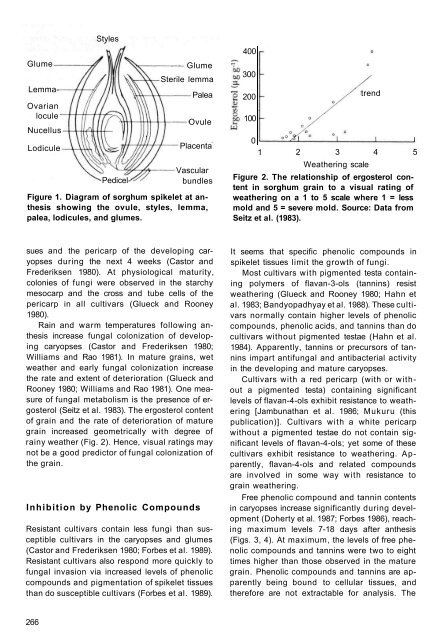Sorghum Diseases in India
Sorghum Diseases in India
Sorghum Diseases in India
Create successful ePaper yourself
Turn your PDF publications into a flip-book with our unique Google optimized e-Paper software.
Glume<br />
Lemma-<br />
Ovarian<br />
locule<br />
Nucellus<br />
Lodicule<br />
Figure 1. Diagram of sorghum spikelet at anthesis<br />
show<strong>in</strong>g the ovule, styles, lemma,<br />
palea, lodicules, and glumes.<br />
sues and the pericarp of the develop<strong>in</strong>g caryopses<br />
dur<strong>in</strong>g the next 4 weeks (Castor and<br />
Frederiksen 1980). At physiological maturity,<br />
colonies of fungi were observed <strong>in</strong> the starchy<br />
mesocarp and the cross and tube cells of the<br />
pericarp <strong>in</strong> all cultivars (Glueck and Rooney<br />
1980).<br />
Ra<strong>in</strong> and warm temperatures follow<strong>in</strong>g anthesis<br />
<strong>in</strong>crease fungal colonization of develop<strong>in</strong>g<br />
caryopses (Castor and Frederiksen 1980;<br />
Williams and Rao 1981). In mature gra<strong>in</strong>s, wet<br />
weather and early fungal colonization <strong>in</strong>crease<br />
the rate and extent of deterioration (Glueck and<br />
Rooney 1980; Williams and Rao 1981). One measure<br />
of fungal metabolism is the presence of ergosterol<br />
(Seitz et al. 1983). The ergosterol content<br />
of gra<strong>in</strong> and the rate of deterioration of mature<br />
gra<strong>in</strong> <strong>in</strong>creased geometrically with degree of<br />
ra<strong>in</strong>y weather (Fig. 2). Hence, visual rat<strong>in</strong>gs may<br />
not be a good predictor of fungal colonization of<br />
the gra<strong>in</strong>.<br />
Inhibition by Phenolic Compounds<br />
Resistant cultivars conta<strong>in</strong> less fungi than susceptible<br />
cultivars <strong>in</strong> the caryopses and glumes<br />
(Castor and Frederiksen 1980; Forbes et al. 1989).<br />
Resistant cultivars also respond more quickly to<br />
fungal <strong>in</strong>vasion via <strong>in</strong>creased levels of phenolic<br />
compounds and pigmentation of spikelet tissues<br />
than do susceptible cultivars (Forbes et al. 1989).<br />
266<br />
Styles<br />
Pedicel-<br />
Glume<br />
Sterile lemma<br />
Palea<br />
Ovule<br />
Placenta<br />
Vascular<br />
bundles<br />
400<br />
300<br />
200<br />
100<br />
0<br />
1 2 3 4 5<br />
Weather<strong>in</strong>g scale<br />
trend<br />
Figure 2. The relationship of ergosterol content<br />
<strong>in</strong> sorghum gra<strong>in</strong> to a visual rat<strong>in</strong>g of<br />
weather<strong>in</strong>g on a 1 to 5 scale where 1 = less<br />
mold and 5 = severe mold. Source: Data from<br />
Seitz et al. (1983).<br />
It seems that specific phenolic compounds <strong>in</strong><br />
spikelet tissues limit the growth of fungi.<br />
Most cultivars with pigmented testa conta<strong>in</strong><strong>in</strong>g<br />
polymers of flavan-3-ols (tann<strong>in</strong>s) resist<br />
weather<strong>in</strong>g (Glueck and Rooney 1980; Hahn et<br />
al. 1983; Bandyopadhyay et al. 1988). These cultivars<br />
normally conta<strong>in</strong> higher levels of phenolic<br />
compounds, phenolic acids, and tann<strong>in</strong>s than do<br />
cultivars without pigmented testae (Hahn et al.<br />
1984). Apparently, tann<strong>in</strong>s or precursors of tann<strong>in</strong>s<br />
impart antifungal and antibacterial activity<br />
<strong>in</strong> the develop<strong>in</strong>g and mature caryopses.<br />
Cultivars with a red pericarp (with or without<br />
a pigmented testa) conta<strong>in</strong><strong>in</strong>g significant<br />
levels of flavan-4-ols exhibit resistance to weather<strong>in</strong>g<br />
[Jambunathan et al. 1986; Mukuru (this<br />
publication)]. Cultivars with a white pericarp<br />
without a pigmented testae do not conta<strong>in</strong> significant<br />
levels of flavan-4-ols; yet some of these<br />
cultivars exhibit resistance to weather<strong>in</strong>g. Apparently,<br />
flavan-4-ols and related compounds<br />
are <strong>in</strong>volved <strong>in</strong> some way with resistance to<br />
gra<strong>in</strong> weather<strong>in</strong>g.<br />
Free phenolic compound and tann<strong>in</strong> contents<br />
<strong>in</strong> caryopses <strong>in</strong>crease significantly dur<strong>in</strong>g development<br />
(Doherty et al. 1987; Forbes 1986), reach<strong>in</strong>g<br />
maximum levels 7-18 days after anthesis<br />
(Figs. 3, 4). At maximum, the levels of free phenolic<br />
compounds and tann<strong>in</strong>s were two to eight<br />
times higher than those observed <strong>in</strong> the mature<br />
gra<strong>in</strong>. Phenolic compounds and tann<strong>in</strong>s are apparently<br />
be<strong>in</strong>g bound to cellular tissues, and<br />
therefore are not extractable for analysis. The








